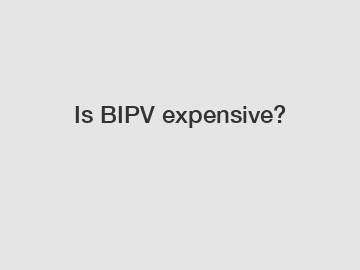Is BIPV expensive?
Is BIPV Expensive?
As the world moves towards sustainable and renewable energy solutions, building-integrated photovoltaics (BIPV) has gained increasing attention. BIPV refers to the incorporation of solar panels directly into building materials, such as windows, facades, and roofs, to generate electricity. However, one question that arises from potential adopters is whether BIPV is expensive. In this article, we will explore the costs associated with BIPV, its advantages, and the factors that contribute to its pricing.
Benefits of BIPV.

Before we delve into the cost aspect of BIPV, let's understand the benefits it offers. BIPV provides a unique opportunity to generate clean and renewable energy while simultaneously fulfilling the functional requirements of a building's envelope. By integrating solar panels directly into the building materials, BIPV systems can reduce the reliance on traditional energy sources and decrease greenhouse gas emissions. Additionally, BIPV systems can improve the aesthetics of buildings by seamlessly blending solar technology into the design.
Exploring the Cost of BIPV.
Now, let's address the primary concern surrounding BIPV – its cost. Although BIPV systems can be more expensive than traditional solar panels, prices have been decreasing steadily as technology advances and economies of scale come into play. The initial investment in BIPV systems can be higher due to the specialized materials and installation techniques required. However, when considering the long-term benefits, BIPV can provide a significant return on investment.
Components Affecting BIPV Pricing.
Various factors influence the pricing of BIPV systems. Here are some key components that contribute to the overall cost:
1. Building design and customization: BIPV systems are tailored to the specific design and requirements of each building. The level of customization needed can impact the cost of materials and installation.
2. Integrated functionality: BIPV systems can serve multiple functions, such as generating electricity, providing shading, or acting as thermal insulation. The additional features integrated into the BIPV system can impact the overall cost.
3. Efficiency: The efficiency of BIPV modules affects their electricity generation capacity. Higher efficiency modules generally come at a higher cost but can provide better long-term returns.
4. Scale: Similar to traditional solar panels, the cost of BIPV systems can vary depending on the scale of the project. Larger installations tend to benefit from economies of scale, resulting in lower costs per unit.
Considerations for BIPV Adoption.
Despite the initial cost associated with BIPV systems, adopters should consider the following points:
1. Energy savings: BIPV systems can significantly reduce a building's reliance on grid electricity, leading to substantial energy savings over the system's lifespan.
2. Government incentives: Many countries offer financial incentives, tax credits, and subsidies to promote the adoption of renewable energy. These incentives can help offset the upfront costs of BIPV systems.
3. Increased property value: BIPV systems can increase the value of a property due to their green credentials and the potential for energy cost savings. This can be a critical consideration for commercial buildings.
Conclusion.
In conclusion, while BIPV systems may initially have a higher upfront cost than traditional solar panels, they offer unique benefits and the potential for long-term savings. Their integration into building materials provides not only an efficient and sustainable energy solution but also enhances the overall aesthetic appeal of the building. Considering government incentives, potential energy savings, and increased property value, the overall cost-effectiveness of BIPV should not be disregarded.
If you are interested in adopting BIPV for your building or want to learn more about its costs and benefits, please contact us. Our team of experts will be happy to assist you and provide the necessary information to make informed decisions.
For more what is bipv, bipv vs bapv, photovoltaic tilesinformation, please contact us. We will provide professional answers.


